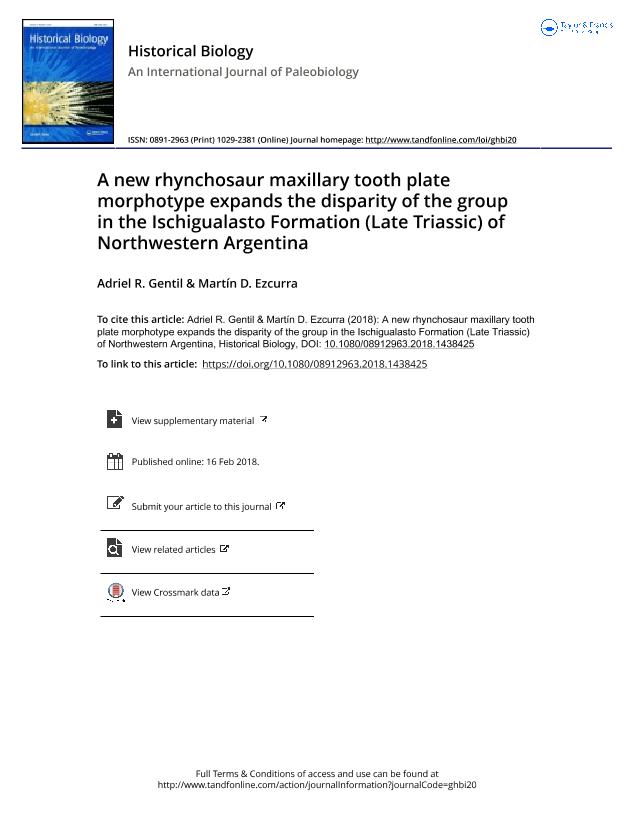Mostrar el registro sencillo del ítem
dc.contributor.author
Gentil, Adriel Roberto

dc.contributor.author
Ezcurra, Martin Daniel

dc.date.available
2020-01-08T14:41:07Z
dc.date.issued
2018-02
dc.identifier.citation
Gentil, Adriel Roberto; Ezcurra, Martin Daniel; A new rhynchosaur maxillary tooth plate morphotype expands the disparity of the group in the Ischigualasto Formation (Late Triassic) of Northwestern Argentina; Taylor & Francis Ltd; Historical Biology; 31; 9; 2-2018; 1223-1230
dc.identifier.issn
0891-2963
dc.identifier.uri
http://hdl.handle.net/11336/93937
dc.description.abstract
Rhynchosaurs are a clade of quadruped, herbivorous stem-archosaur diapsids restricted to the Triassic Period. The group became globally distributed and the numerically dominant tetrapods of several terrestrial ecosystems before their extinction. Derived rhynchosaurs are characterized by a specialized masticatory apparatus, composed of a blade-and-groove occlusion with multiple longitudinal maxillary tooth rows. The morphology of the maxillary tooth plate has shown to be taxonomically and phylogenetically informative. So far, two rhynchosaur maxillary tooth plate morphotypes are known in Argentina, one belonging to an unnamed stenaulorhynchine from the Chañares Formation and the other to the hyperodapedontine Hyperodapedon sanjuanensis, the single rhynchosaur species currently name for the Ischigualasto Formation. Here we describe a new rhynchosaur maxillary tooth plate morphotype based on an indeterminate hyperodapedontine specimen from the Ischigualasto Formation. This maxillary tooth plate (PVL 2728) possesses a single longitudinal groove that divides symmetric lateral and medial tooth-bearing areas with relatively large tooth crowns, which is an uncommon combination of features among hyperodapedontines. These qualitative observations in addition to quantitative analyses show that the morphology of PVL 2728 differs from that of, at least, other sampled South American rhynchosaurs. Therefore, this specimen expands the morphological disparity of rhynchosaurs in northwest Argentina and southwestern Pangaea.
dc.format
application/pdf
dc.language.iso
eng
dc.publisher
Taylor & Francis Ltd

dc.rights
info:eu-repo/semantics/openAccess
dc.rights.uri
https://creativecommons.org/licenses/by-nc-sa/2.5/ar/
dc.subject
ARCHOSAUROMORPHA
dc.subject
DENTITION
dc.subject
HYPERODAPEDON
dc.subject
ISCHIGUALASTO-VILLA UNIÓN BASIN
dc.subject
RHYNCHOSAURIA
dc.subject.classification
Paleontología

dc.subject.classification
Ciencias de la Tierra y relacionadas con el Medio Ambiente

dc.subject.classification
CIENCIAS NATURALES Y EXACTAS

dc.title
A new rhynchosaur maxillary tooth plate morphotype expands the disparity of the group in the Ischigualasto Formation (Late Triassic) of Northwestern Argentina
dc.type
info:eu-repo/semantics/article
dc.type
info:ar-repo/semantics/artículo
dc.type
info:eu-repo/semantics/publishedVersion
dc.date.updated
2019-10-16T19:29:52Z
dc.identifier.eissn
1029-2381
dc.journal.volume
31
dc.journal.number
9
dc.journal.pagination
1223-1230
dc.journal.pais
Reino Unido

dc.description.fil
Fil: Gentil, Adriel Roberto. Consejo Nacional de Investigaciones Científicas y Técnicas. Oficina de Coordinación Administrativa Parque Centenario. Museo Argentino de Ciencias Naturales “Bernardino Rivadavia”; Argentina
dc.description.fil
Fil: Ezcurra, Martin Daniel. Consejo Nacional de Investigaciones Científicas y Técnicas. Oficina de Coordinación Administrativa Parque Centenario. Museo Argentino de Ciencias Naturales “Bernardino Rivadavia”; Argentina
dc.journal.title
Historical Biology
dc.relation.alternativeid
info:eu-repo/semantics/altIdentifier/doi/http://dx.doi.org/10.1080/08912963.2018.1438425
dc.relation.alternativeid
info:eu-repo/semantics/altIdentifier/url/https://www.tandfonline.com/doi/full/10.1080/08912963.2018.1438425
Archivos asociados
